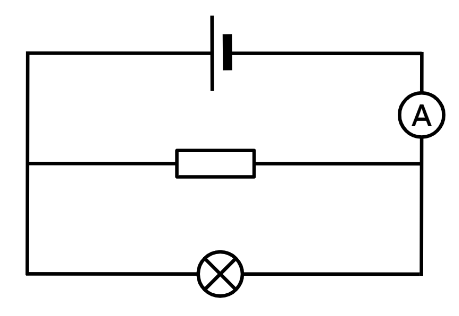Starter quiz
- Which of the following statements about current in a series circuit is correct?
- The current decreases as it travels through the circuit.
- There is a lower current through a component, e.g. a resistor, than a battery.
- All the current flows through all the components. ✓
- Components with resistance use up the current.
-
- Which of the following quantities is an ammeter used to measure?
- voltage
- current ✓
- resistance
- force
-
- Which of the following units is current measured in?
- amperes ✓
- volts
- ohms
- farads
-
- Which of the following statements about current through a metal wire is correct?
- Current is the flow of electrons per second. ✓
- Current is the speed with which electrons move.
- Current is the push of the electrons.
- Current is the flow of protons through the wire.
-
 What is the reading on the ammeter?
What is the reading on the ammeter?- 0.0 A
- 0.1 A
- 0.2 A
- 0.3 A
- 0.4 A ✓
-
- Which of the following statements about an ammeter is correct?
- The symbol for an ammeter is an 'a'.
- An ammeter has a very, very low resistance. ✓
- An ammeter has a high resistance.
- An ammeter only lets some of the current in a series circuit flow through it.
-
Exit quiz
- A parallel circuit contains a battery and several branches that have different components on. Which of the following statement is correct?
- The current in all the branches will always be equal.
- The current in the branches will be greater than the current in the battery.
- The total current in the branches will be less than the current in the battery.
- The total current in the branches will be equal to the current in the battery. ✓
-
- Starting with the first step, sort the following steps into the correct order to form a method for adding an ammeter to a circuit to measure the current.
- 1⇔Choose the place in the circuit where you want to measure the current.
- 2⇔Disconnect the leads as near to this point as you can.
- 3⇔Place an ammeter in the gap and connect one side to the end of one lead.
- 4⇔Connect the other lead to the other side of the ammeter.
- 5⇔Check the ammeter is working and take the reading.
 Which component is the ammeter in the circuit shown measuring the current through?
Which component is the ammeter in the circuit shown measuring the current through?- the battery ✓
- the resistor
- the lamp
- the lamp and the resistor ✓
-
- What is the rule for current at junctions in a parallel circuit?
- Current going into the junction equals current going out of the junction. ✓
- Current going into the junction is less than current going out of the junction.
- Current going into the junction is more than current going out of the junction.
-
 What is the current through the electric cell in the circuit shown?
What is the current through the electric cell in the circuit shown?- 0.20 A
- 0.40 A
- 0.60 A ✓
- 0.80 A
-
 What is the current through the lamp in the circuit shown?
What is the current through the lamp in the circuit shown?- 0.20 A
- 0.40 A
- 0.60 A ✓
- 0.80 A
-
Worksheet
Loading worksheet ...
Presentation
Loading presentation ...
Video
Lesson Details
Key learning points
- Current through the battery in a parallel circuit is measured with an ammeter, connected next to one end of the battery.
- There are connections to the rest of the circuit at the ends of each branch in a parallel circuit.
- The current through a branch of a parallel circuit is measured between its connections to the rest of the circuit.
- The current through each branch of a parallel circuit adds up to the total current through the battery.
Common misconception
Pupils often analyse circuits sequentially, starting from the battery, which makes predicting what current does at a junction impossible.
Teach pupils to analyse each complete loop of a parallel circuit as whole loops. The currents through each loop then add to give the current through the battery (rather than current from the battery miraculously ‘knowing’ how to split at a junction).
Keywords
Ammeter - a device that measures the current flowing in a circuit
Amps - the unit that current is measured in (short for amperes), represented by the symbol A
Branch - a separate loop in a parallel circuit
Parallel circuit - a circuit with more than one complete loop, from one end of a battery round to the other end
+